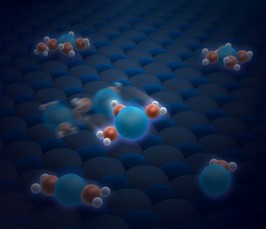Full Quantum Nature of Water on Salt Surface
MPSD Seminar
- Date: Sep 25, 2019
- Time: 02:00 PM - 03:30 PM (Local Time Germany)
- Speaker: Enge Wang
- International Center for Quantum Materials and School of Physics, Peking University & Institute of Physics, Chinese Academy of Sciences
- Location: CFEL (Bldg. 99)
- Room: Seminar Room IV, O1.111
- Host: Angel Rubio
- Contact: office.rubio@mpsd.mpg.de

Full image caption:
We constructed individual sodium ion (Na+) hydrates on a NaCl(001) surface by progressively attaching single water molecules (one to five) to the Na+ ion using a combined scanning tunnelling microscopy and noncontact atomic force microscopy system. It is found that the Na+ ion hydrated with three water molecules diffuses orders of magnitude more quickly than other ion hydrates. Ab initio calculations revealed that such high ion mobility arises from the existence of a metastable state, in which the three water molecules around the Na+ ion can rotate collectively with a rather small energy barrier.
About Enge Wang:
Enge Wang is the Professor of Physics, Peking University. He is also the Chairman of Advisor Board of Institute of Physics and the Honorary Director of Kavli Institute of Theoretical Sciences, Chinese Academy of Sciences. He was the Director of the Institute of Physics, the Provost and President of Peking University, and the Vice President of Chinese Academy of Sciences from 1999 to 2017. He was selected as the Vice President of the International Union of Pure and Applied Physics (IUPAP) in 2017 and the International Councilor of American Physical Society (APS) in 2018. He researches condensed matter physics; the approach is a combination of theoretical and experimental study of light-element materials.